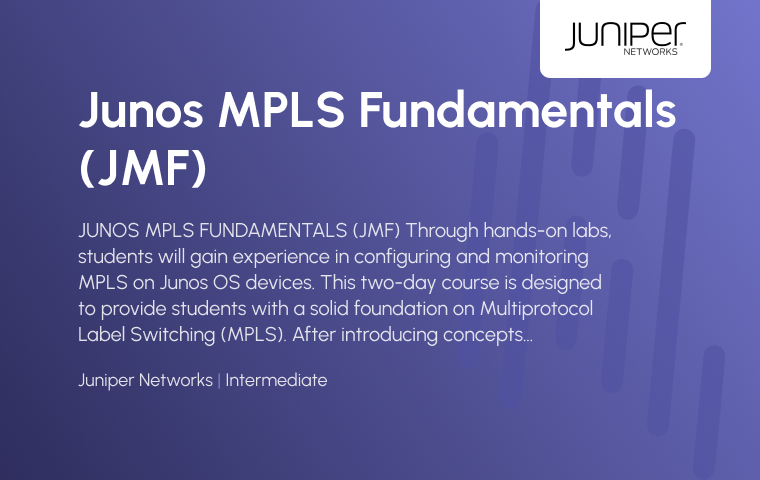
Junos MPLS Fundamentals (JMF)
This two-day course is designed to provide students with a solid foundation on Multiprotocol Label Switching (MPLS). After introducing concepts such as MPLS forwarding and the structure of the MPLS header, the course will delve into the configuration and operation of the two main label distribution protocols, RSVP and LDP. Special emphasis is given to the central topics of traffic engineering and MPLS traffic protection, including fast reroute, link/node protection, and LDP loop-free alternate. The concepts are put into practice with a series of in-depth hands-on labs, which will allow participants to gain experience in configuring and monitoring MPLS on Junos OS devices. These hands-on labs utilize Juniper Networks vMX Series devices using the Junos OS Release 19.2R1.8, and are also applicable to other MX Series devices.
Virtual Classroom Live
Prerequisites
Students should have intermediate-level networking knowledge and should be familiar with the Junos OS command-line interface (CLI). Students should also attend the Introduction to the Junos Operating System (IJOS), Junos Intermediate Routing (JIR), and Junos Service Provider Switching (JSPX) courses prior to attending this class.
Target Audience
What You’ll Learn
Course Outline
Labs Outline
Related Certifications
- Describe the history and rationale for MPLS, as well as its basic terminology.
- Explain the MPLS label operations (push, pop, swap) and the concept of label-switched path (LSP).
- Describe the configuration and verification of MPLS forwarding.
- Describe the functionalities and operation of RSVP and LDP.
- Configure and verify RSVP-signaled and LDP-signaled LSPs.
- Select and configure the appropriate label distribution protocol for a given set of requirements.
- Describe the default Junos OS MPLS traffic engineering behavior.
- Explain the Interior Gateway Protocol (IGP) extensions used to build the Traffic Engineering Database (TED).
- Describe the Constrained Shortest Path First (CSPF) algorithm, its uses, and its path selection process.
- Describe administrative groups and how they can be used to influence path selection.
- Describe the default traffic protection behavior of RSVP-signaled LSPs.
- Explain the use of primary and secondary LSPs.
- Describe the operation and configuration of fast reroute.
- Describe the operation and configuration of link and node protection.
- Describe the operation and configuration of LDP loop-free alternate.
- Describe the LSP optimization options.
- Explain LSP priority and preemption.
- Describe the behavior of fate sharing.
- Describe how SRLG changes the CSPF algorithm when computing the path of a secondary LSP.
- Explain how extended admin groups can be used to influence path selection.
- Explain the purpose of several miscellaneous MPLS features.

